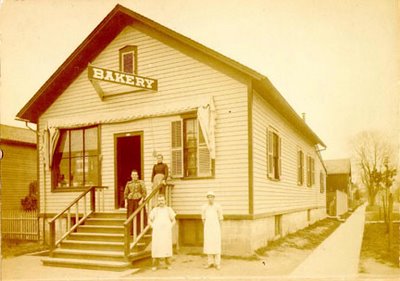This article was originally posted on December 27, 2006
The tradition of the New Year's Pretzel appears to date from the turn of the 20th century in Sandusky. As the city of Sandusky grew, it was home to a very large German population. Sandusky had German neighborhoods and even supported a German language newspaper or two. It was the strong influence of the German community that brought about a holiday tradition known to very few communities.
The New Year’s Pretzel is different from the pretzels we know today. It is soft and made from an egg dough, and instead of being sprinkled with salt, it is washed with a glaze. The finished product is chewy. The pretzels were anywhere from 15 to 36 inches across and were made by a number of bakeries in Sandusky, including Becherer, Frank’s (pictured here, at 834 Columbus Ave.), Knoerle, Feddersen, Kanzler, Schweinfurth, Michel, Smith’s, Sandusky Baking, H & S, Park, and others.

The pretzels are usually eaten for breakfast on New Year’s Day. Wilbert Ohlemacher recalled that his father would hang the pretzel by a ribbon from the gas chandelier over the dining room table. He would cut the ribbon and then cut the pretzel into smaller pieces for everyone in the family. When the custom was practiced in early Sandusky, the pretzels were often decorated with intricate braids made from the same dough.
There are a few different theories about the origins of the German New Years Pretzel. One is that they were first baked by monks in Southern Germany as a reward for children who learned their prayers. Thus they were shaped to represent the crossed arms of a child praying.
Another story is that the circular shape of the symbolic loaf is derived from the old calendar sign for the winter solstice, which was a circle with a dot in its center. The central cross was added to represent the four seasons.
Yet another story tells of German citizens parading through the streets with pretzels piled onto long sticks, and groups of people would go calling on friends and relatives and exchange pretzels instead of greetings.
While the exact origin is unknown, the New Years Pretzel is fondly remembered by countless residents of Sandusky.

 this blog
this blog
































